










This think piece invites students to reflect on the roles of citizens and government working together for the good of society.
“[W]e find ourselves now at a crossroads in our nation’s journey.”
- Deputy Prime Minister (DPM) Lawrence Wong
At the launch of the Forward Singapore exercise, Deputy Prime Minister Lawrence Wong laid bare the challenges that lie ahead for Singapore, which the 4G government aims to resolve with the help of all Singaporeans.

The problems faced by the various generations of Singaporeans are very different:
a competitive education system for youths; high costs of living for adult Singaporeans; and difficulties faced by the elderly in reemployment.
These are problems that need to be resolved concurrently. A failure to do so might result in a breakdown of our social compact*, alienating segments of society. Consequently, our social fabric would fracture when these segments of society lose faith in the government’s abilities to hear and care for them – a scenario that we should seek to avoid. In this regard, it is crucial for the government to work with and alongside all Singaporeans to strengthen our social compact; to work together for the good of society Hence, the Forward SG exercise
To anchor the Forward SG exercise, DPM Wong offered a series of questions for consideration:
How do we ensure every Singaporean is able to maximise their potential?
How do we provide better care for Singaporeans?
How do we manage the trade-offs to meet today’s needs while ensuring our future generations are able to continue to build better lives for themselves?
* What is a social compact? Find out more here.

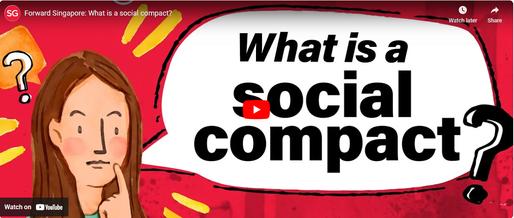
A social compact is an implicit agreement between the government and the people on the roles and responsibilities each play, so that together we can shape the growth of society
How do we continue to unite Singaporeans and take Singapore forward?
DPM Wong shared that the government has put in place some building blocks to resolve these questions, such as
investing in pre-school education; upskilling adult Singaporeans; providing adequate social safety nets; and introducing a new legislation for fair employment practices
But he added that the government cannot legislate everything to resolve these issues. This is where Singaporeans can come in to help influence the decision-making in public affairs. By lending their voice to respond to the issues and challenges faced by Singaporeans, they can help the government find possible solutions. In the process, this would strengthen Singaporeans’ sense of belonging.
Organised along six pillars (Empower, Equip, Care, Build, Steward, and Unite), the exercise will engage Singaporeans to understand their concerns, listen to their feedback, and explore the trade-offs involved in various policy shifts. In the process
process, policies will be reviewed and updated, with new partnerships established along the way to implement changes.
One of the themes in this year ’ s Budget was moves to strengthen the social compact. For example, some initiatives announced in the Budget included the increased tax on luxury cars, higher-value properties, and tobacco products. These measures, according to UOB’s Head of Research, Mr. Suan Teck Kin, constitutes a form of signalling by the government that it is addressing the income divide, an issue that DPM Wong had previously engaged Singaporeans on at a Forward SG dialogue in October 2022
Apart from dialogues, the exercise also taps existing platforms and organisations to promote such conversations between the government and Singaporeans on refreshing the social compact. For example, the exercise had tapped organisations such as REACH, the Singapore government's feedback unit, and the Singapore Scout Association, amongst other government and non-government entities, to engage Singaporeans from all walks of life. Utilising a variety of engagement strategies, participants are given the autonomy to suggest, vote on and lead topics of discussions that they are concerned about.


“More employers should offer flexible working arrangements for those with accessibility issue If we have the skills for a deskbound job, allow us to work from home and not reject our application if the office is not wheelchair-friendly ” 5

4

On creating more support for caregivers 5
“There should be more resources to support caregivers in helping their charges manage end-oflife financial matters ”
On how Singaporeans can refresh the social compact 5
Each of us should be curious enough to continuously learn and take nitiative to share knowledge with our ommunities Host seminars, interest roups, brown bag sessions. You will never know when an interest can develop into a useful skillset.”
Engagements with a wider group of Singaporeans will also be launched through new digital platforms and physical pop-up exhibitions, where Singaporeans can contribute their thoughts on what it means to be one united people The findings gathered from these engagements will inform policy recommendations that will be included in the overall Forward SG report to be published at the end of the exercise.
Have a suggestion to bring Singapore forward? Share it here
You can also encourage your colleagues and students to share their views and ideas about the Singapore that they want to see.
1. Why are citizens encouraged to engage with the government to propose new solutions?
2. Would you take part in the Forward SG exercise to resolve specific problems in society? Why or why not?
3a. What are some other appropriate ways to express views, engage in debates with fellow citizens and government representatives, and come up with solutions?
3b. Are there less appropriate ways of doing so? Why do you think they are less appropriate?
[1] https://www sg/news/speech-by-dpm-lawrence-wong---launch-of-forward-singapore-exercise-on-28june-2022
[2] https://www straitstimes com/singapore/budget-2023-designed-to-support-families-signals-thebeginning-of-a-new-s-pore-indranee
[3] https://www straitstimes com/singapore/spore-to-refresh-social-support-measures-amid-signs-ofstratification-dpm-wong
[4] https://www sg/stories/series-of-citizen-led-open-discussions

[5] https://www sg/stories/my-forward-sg-idea-narresh-syafiqa-reuben
[6] https://www sg/news/factsheet-forward-singapore-the-unite-pillar Thoughts & Ideas?
Are there other topics that you would like us to cover? Suggest a topic to us at https://go.gov.sg/sharewithus23

An SLS Lesson with Gaming Interactive: Care Among Us
Introduction
This section features a lesson idea for Book 4 Chapter 1 for Secondary 4 Normal (Technical) students.
Book 4
Inquiry Focus
Guiding Question
Topic
Key Understanding
Building a Caring Nation and an Inclusive Society
How can we make Singapore a better place for everyone?
What does it mean to care?
The meaning of care and ways to care
Everyone has the responsibility to care for other members of society
This section draws upon the following resources:
Book 4 Chapter 1, pages 4 to 8; Lesson idea Period 1 – click here to access the lesson idea; and SLS lesson with game interactive – click here to access the SLS lesson.
Sparking Curiosity
Using an online word cloud generator such as Mentimeter or Poll Everywhere, invite students to share what words or actions come to mind when they see the word “ care ” . For words of greater prominence, invite a few students to share their responses
Asynchronous Learning Opportunity!

Teachers may conduct this part of the lesson outside the classroom by modifying the “Let’s Get Started” tab of the SLS lesson, adding an Interactive Thinking Tool (ITT) that asks the following:
“What comes to your mind when you see the word ‘ care’?”
With reference to the images on pages 4 and 5 of the coursebook, explain to students that caring means showing kindness and compassion to the people around them This can include their family, friends and people in the community
Refer students to page 6 of the coursebook to introduce how being attentive, responsive and competent can help them to care for others effectively. For example:
To care for others, you must first look out for other people’s needs (being attentive) before taking action to meet their needs (being responsive).
In order to ensure that the needs of the person are met, you must respond appropriately to care for them or offer help. It helps if you have the suitable skills and knowledge to meet those needs (being competent)

Have students explore the game “Care Among Us” on SLS and complete two tasks in each of the five scenarios given:
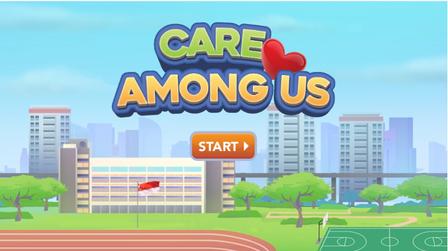
Task 1: Identify the person who needs help, and Task 2: Select the most appropriate way to help.


The five scenarios present different scenes that are common in our daily lives. Through the game, students have the opportunity to be attentive and responsive to the needs of others.
Scenario 1: On the MRT
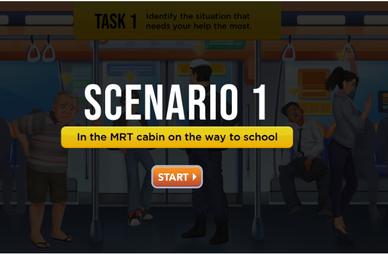
Scenario 2: In the school canteen
Scenario 3: During a CCA session
Scenario 4: In the void deck
Scenario 5: At home
Teachers may conduct this part of the lesson by getting students to attempt the game before the lesson.
Have students study the comic strip on page 7 of the coursebook to find out what it means to be attentive, responsive and competent in caring for others. Then, have them answer the questions on page 8 using Think-PairShare
Students think individually and jot down their responses to the questions on page 8. They then pair up and take turns to share their responses with their partners. Students can add on to their own responses when they gain different or new insights from their partners.
Invite pairs to share their responses with the class Get different pairs to answer each of the questions for a good representation of views.
Think-Pair-Share engages all students in the classroom, especially those who might be shy to voice their views . It also gives students time to independently think and apply the knowledge learnt before articulating their ideas to others. This provides them with the opportunity to learn actively and collaboratively with their peers to build a deeper understanding of how they can apply their knowledge of care.
Wrap up by summarising the ideas shared and pointing out that being attentive, responsive and competent has helped Krishna care for his friend Vanessa
Have students respond to the two questions in the ITT in the “Let’s Consolidate” tab:
What is one way you can care for your loved ones?
What is one way you can care for others in your community (e.g., school, neighbourhood)?
Through these questions, students reflect on their learning on what it means to care and how they can care for others to make our community a better place to live and work in.
Sparking Curiosity Sparking Curiosity
Students activate their prior knowledge of the meaning of care through ideas crowdsourced in a word cloud.
Students reflect on their understanding of what it means to care, and on their individual responsibility in caring for others to improve our community
Gathering Data Gathering Data
Students gather ideas on the ways individuals can show care by studying real-life examples presented in print and digital sources.
Students provide responses on what it means to be attentive, responsive and competent in caring for others. They also explore differing views from their classmates during the discussions

Helping Students Learn About Managing Trade-Offs Using Structured Academic Controversy (SAC)
This section features a lesson idea for Chapter 3 2: Managing trade-offs in the 2023 Express/Normal (Academic) syllabuses This section draws upon the following resources:
1. 2. 3 4
Suggested lesson idea for Chapter 3 hosted on OPAL2.0
IDT Lessons 3.2 Managing Trade-Offs (Discussion) and 3.2 What are Trade-Offs?
Secondary 3 Social Studies Coursebook, pages 76–82
2023 SS E/N(A) e-TLG, Section 3 2 4: Discussion-based strategies, pages 169–173
This lesson idea focuses on how teachers can facilitate a discussion to help students learn about managing trade-offs using the Structured Academic Controversy (SAC) discussion strategy, conducted using the Student Learning Space (SLS).

The article contains alternative suggestions for custo the lesson to better suit the profile of your students.

In this lesson, students learn:
` 1 how to deliberate over a societal issue; and
2. how trade-offs may be managed by the governmen
The lesson also allows students to think about the broader Inquiry Focus: How do we decide what is good for society? by examining the case study of the Cross Island Line (CRL) project. Students will explore the inquiry question: “Which would better serve the needs and interests of Singaporeans –the direct or skirting route?”
Teachers can refer to the 2023 SS E/N(A) eTLG - Use of Social Studies
IDT and Customisation with Coursebook, pages 77–78, for more information about customising IDT lessons.
Teachers may want to get students to complete the “Let’s Buzz” activity (pages 66–69) to get students to explore the meaning of “trade-offs” at a personal level before extending their understanding to the national context (CRL).
The teacher explains the SAC procedure to students and goes through discussion norms before organising students into groups of four. Students are to be further split into two pairs, with one pair taking up Position A and the other pair taking up Position B in the discussion.




Some examples of discussion norms specific to SAC that can be used:
I am critical of ideas, not people I focus on making the best decision possible, not on “winning”.
I encourage everyone to participate and master all the relevant information.
I listen to everyone ’ s ideas even if I do not agree. I try to understand both sides of the issue.
I change my mind when evidence clearly indicates that I should do so
Pre-lesson: Teachers may assign the “Let’s Get Started!” tab of the IDT lesson as homework to students prior to conducting this lesson in the classroom
Actual lesson: In the classroom, invite students to ask questions if they are unsure about the context and invite one or two students to share the main points.
To provide context for the discussion topic, get students to complete the “Let’s Get Started!” activity tab in IDT Lesson 3.2 Managing Trade-Offs (Discussion).
The teacher may invite one or two students to share the main points of what they have read. The teacher can then address any misconceptions. Students will then discuss which route the CRL should take to best serve the needs and interests of Singaporeans.
The teacher begins the SAC by inviting stud to access the “Let’s Explore” activity of the discussion lesson In pairs, students are to the set of sources assigned to their posit They will then discuss to agree on t arguments, with supporting evidence, that want to share with the other pair in the g by answering Q1a–1c.
Teacher may wish to provide useful questions / statements to facilitate effective group discussions: Refer to source 3A here.
Subsequently, each pair takes turns to present their position to the other pair in the group The listening pair should take notes (by answering Q2 in the IDT discussion lesson) while listening carefully to their groupmates. They can also jot down clarifying questions to be raised when the presenting pair have finished their presentation.
When both pairs in the group have presented to each other, the four members of the group are to drop the original positions assigned to them. They need to consider the strengths of all the arguments raised and reach a group consensus on the position they want to adopt. Students are to indicate this by responding to Q3 in the “Let’s Explore” tab of the IDT discussion lesson
Alternatively,
Teachers may direct students to the sources on pages 78–79 of the Secondary 3 coursebook.
In their pairs, students are to read the set of sources assigned to their positions They will then discuss to agree on three arguments, with supporting evidence, that they want to share with the other pair by filling in the purple (Side A) or orange (Side B) box on page 81. Subsequently, each pair takes turns to present its position to the other pair in the group.
The listening pair should take notes while listening. They are also to write at least one question that they would like to ask the opposing side to help them understand their arguments better (Q2 on page 81)
Students will then decide on and record their group consensus on Q3 on page 81 of the coursebook
Teachers can end the SAC by inviting a few groups to present their group consensus Teachers may also choose to ask probing questions to guide students to substantiate their responses.
Following the presentation of some of the groups ’ consensus, the teacher can use questions to draw out the concept of trade-offs. Possible questions include:
What is your group ’ s decision? What would be the benefits stemming from your group ’ s decision? What would be the negative effects?
Was it easy to reach a group decision? Why or why not
Is it always possible to reach a decision where there are only benefits and no negative effects?
Using the students’ responses, the teacher introduces the concept of trade-offs Trade-offs are involved when deciding between two or more things that cannot be obtained at the same time due to limited resources. This means that having more of one thing would result in having less of another.
To conclude the lesson, the teacher instructs students to complete the “Let’s Reflect and Consolidate” activity in the IDT discussion lesson
Alternatively, teachers may get students to respond to Q1–3 on page 82 of the coursebook.
To check students’ understanding of the concept of trade-offs, the teacher instructs students to complete the IDT lesson 3.2 Managing trade-offs as homework.

The suite of Lesson Ideas for the Secondary 3 E/N(A) syllabuses will be progressively updated here
Chapter 5 IDT course is now live on SLS! Access it easily at: https://go.gov.sg/sssch5
Do you have any feedback on the use of IDTs? Tell us about it at: https://go.gov.sg/idtfeedback

We hope you found the articles in iSSues Explorer useful! We want to continue providing you with relevant and useful resources for your teaching and learning of Social Studies.

We invite you to share your feedback and ideas HERE or scan the QR code.



growing as aN SS educator, thriving as one fraternity
PD Opportunity: Issues-based seminar 2

Participants will explore:
challenges of living in a socio-economically diverse society;
how the government-financed approach and the shared responsibility approach address these challenges; and
ways to guide students' inquiry into the issue of socio-economic diversity
20 April, Thursday (T2W5)
Registration Deadline: 10 April, Monday

“There was so much interesting insight about shared values - e.g. on whether it is top-down or grounds up, how it has evolved and implication of the evolution of shared values - these rich discussions are food for thought that can be applied into the classroom to help students deepen and broaden their understanding of knowledge outcome!"

understand how shared values can contribute to national identity and nation building”
SS Micro-Learning Unit (MLU): customising SS N(T) Performance Task for diverse learners

this MLU, you will find out how you n customise the Performance Task for erse learners using the Continuum of ded Inquiry.
Click HERE to access the MLU on OPAL2.0 or scan the QR code.
Social Studies Secondary (SSS) Wikipage User Guide

Check out this user guide to find out more on how to access and navigate the SSS Wikipage!

Click HERE to access the user guide on OPAL2 0 or scan the QR code.

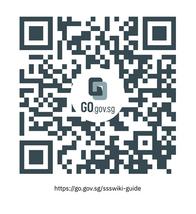
2020 ss N(T) Syllabus
Sec 1 N(T) Issue 1, Chapter 2
Sec 2 N(T) Issue 3, Chapter 4
Sec 3 N(T) Issue 5, Chapter 2
Book 1A - Developing better understanding and appreciation of different cultures

Book 2A - What is terrorism?
Book 3 - Understanding the economic impact of globalisation

Keying in of SS N(T) Grades in School Cockpit (SC) 2.0
Keying in of SS N(T) Grades in School Cockpit (SC) 2.0
The SS N(T) grades should be reflected in the Holistic Development Profile (HDP) at the end of each semester for Lower Secondary levels
The grades are Pass (PA), Pass with Merit (ME) and Pass with Distinction (DI). Students who do not attempt the PT should be given “Ungraded” in the reporting of assessment grades at the end of each semester.
Lower secondary N(T)
Grades for Lower Secondary N(T) students are to be entered in the:
“Term 2 Weighted Assessment” column for Semester 1; and “End-of-year Exam” column for Semester 2.
Upper Secondary N(T)
Schools have the option of reflecting the SS N(T) grades at the end of the first or second semester depending on whether the syllabus is allocated double periods in the first or second semester
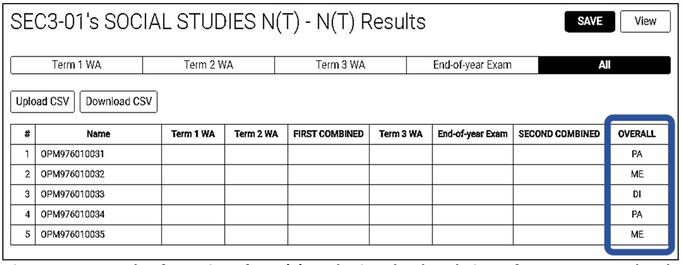
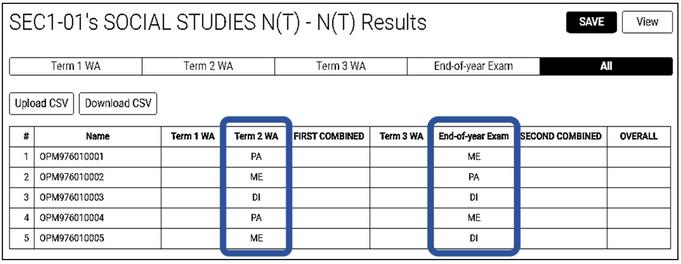
Grades are to be entered in the “Overall” column
Teachers may refer to 2020 SS N(T) TLG pg. 95-96 for more details about Assessment
Grade Reporting
If you know any Social Studies teachers who please drop us an email at sim jie kai@moe.gov.sg
have not been receiving our e-newsletters; or are not on our mailing list (especially Beginning Teachers);
Example of entering of SS N(T) grades in School Cockpit 2.0 for Lower Secondary N(T) levels Example of entering of SS N(T) grades in School Cockpit 2.0 for Upper Secondary levels